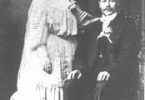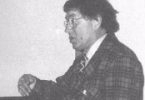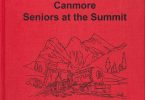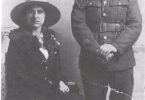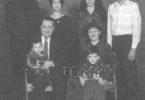On this first warm day in the spring of the year 2000, George and I are sitting on the deck, having finished our lunch, and now soaking up the relaxing warmth of the sun. Across the valley, the snow on the peaks of the Three Sisters gleams against the cobalt blue of the sky, and the peace of the day floods our beings. The echoing crack of an avalanche from the top of Mt. Rundle far across the valley rouses us from our reverie, and we quickly look up to watch a huge snow slide racing down the distant slopes. As we once again settle back in our chairs, I am thankful that we live in this beautiful valley surrounded by the majestic snow-capped mountains. I think back to the events in our life that led us to this moment in time, in this wonderful place on this glorious day …
“Hey Casey!” my nickname rings out as I drive on to a downtown Toronto parking lot to attend a meeting of the British Empire Motor Club. A month earlier I had bought a marvelous little sports car from Autosport, highly regarded sports car centre, in Cooksville, Ontario. My new car, a gorgeous little 1952 MG TD, cream coloured with green leather upholstery, is my prized possession. When I pull into the parking stall, George Raham appears beside my car. I have known George since public school, although we have not seen each other for many years. “I didn’t know that you had a TD,” he said. “I have one too. See, over there, the black one with red under the fenders.” That was the start of our enduring relationship, and we still have that wonderful little black and red MG to this day. Cars had always been a big part of my life. My father was an auto mechanics teacher at Jarvis Vocational School in downtown Toronto. The dinner table conversation between my brother and my dad often focused on mechanical topics concerning many different types of vehicles. Unknowingly, I absorbed a lot of that knowledge, and thus developed a great understanding of motorcars.
George and I found that we shared a great interest in motorsport. He had learned to drive at age thirteen, in his father ‘sModel T. When he was sixteen, he had what was called a Chauffeur’s Licence, which allowed him to drive any commercial vehicle. Whereas I was nineteen, teaching school, and had bought my first car, a 1941 Ford Convertible, before I even had a driver’s licence. We became heavily involved in the early days of the sports car movement in Canada. We entered rallies, gymkanas (driving skill tests), hill climbs, economy runs, and races, (George raced, I watched). We acted as flag marshals at race courses, and we were present at the formative meetings when a brand new race course near Toronto was being planned. The club members decided to name the new area “MOSPORT” a short form for the words motor sport. The Mosport circuit remains an important race venue in Eastern Canada today. George was appointed Licence Registrar for the Canadian Automobile Sport Club, the governing body for motorsport in Canada. He was in charge of issuing licences to those drivers who wished to compete in high speed events. He held that post for three years until we moved to Calgary, when he took over the position for the Prairie Region.
In 1954, when we met, George was employed by the Disher Steel Company, on Commissioner Street in Toronto, apprenticing as a structural steel draftsman, and attending the Provincial Institute of Trades to further his education in the structural steel industry. As for myself, I was teaching grade three at Niagara Street Public School, which was located on Niagara Street between King and Queen Streets, in Toronto. During the warm months, when I drove my MG to work, I discovered that some younger children had found the sloping fenders on my car made an irresistible little slide, and at one point I set up a makeshift guard, where deserving students from my class stood on watch beside the car for fifteen minutes before classes, to see that no obstreperous little person could take advantage of my portable playground apparatus. This arrangement only lasted for a little over a week, and then was no longer necessary as word spread that Miss Case did not look fondly upon such behavior.
As George and I began to see more and more of each other, and soon realized that marriage was in our future, we set our wedding date for the following July 1, 1955. All plans went full steam ahead, and we arranged for our wedding to be held at St. Timothy’s Anglican Church, where I was a member of the church choir. I designed and made my own wedding dress, as well as the attendants’ dresses. Plans continued along at a satisfying pace, and meanwhile, we purchased a house at 180 Fairlawn Avenue, in north Toronto. As the wedding day approached, painting and decorating took over our lives, and after putting in a full day at work, we would spend evenings and weekends working on our new home.
This hectic pace continued right up until the day of our wedding, when unfortunately, on the morning of our big day, I awoke with a very high fever, which caused great alarm in the household, and eventually proceeded to throw all our well laid plans out the window. My parents phoned George, to notify him, and he came down to visit with me, but could obviously do nothing to help the situation. Frantic plans were developed to alter the wedding location, as I was determined that we were to be married on our selected day. All friends were duly notified of the change and my brother Al was sent to meet the people arriving at the church, to inform them that the ceremony would not be taking place there. When our minister, the Reverend Henry Marsh, (later to become Bishop of the Yukon) entered the room, and saw me lying in bed with George sitting beside me, he remarked cryptically, “Well, I can see that I am just in the nick of time!” Thus it came to pass that we were married in the very crowded front bedroom of my parents’ house at 92 Glengarry Avenue, Toronto, the very room in which I was born, some twenty-two years earlier. Now how many people can say that?
Our life together centered mainly around sports car club activities, and we continued to enter all kinds of events. In due course, we found it necessary to sell one of our cars. The decision as to which one to keep was not difficult to make, as my MG had been well used, having been “souped up” with little extras and driven hard by previous owners, whereas George had taken very good care of his 1951 model since it was new and therefore it remained in excellent condition. When working on the cars, we were often amused by the language used in the official MG car manual. For example, the hub cap was referred to as the “knave plate”, and to replace the hub cap on the wheel was to “offer up the knave plate”. It was like learning a completely different language!
On July 19, 1956, our firstborn, Douglas George Raham, arrived in this world at the Grace Hospital, Toronto. Upon discharge from the hospital, we put our brand new baby son in a well padded cardboard box that fit nicely in the MG, in a small area behind the seat, and proudly drove home with him. When he was ten days old we traveled to my parent’s “farm” at Clarksburg, on Georgian Bay about one hundred miles north of Toronto, to spend the weekend. Baby Doug seemed to love car travel and slept almost as soon as the car began moving. We continued to enter rallies with Doug bouncing along the rough roads snugly sound asleep in his little box behind us. Many times organizers allowed us a time out, if needed, to do unusual rally maintenance, such as changing diapers or nursing the baby.
In the winter of 1956, George entered our car in the Canadian Winter Rally. This was a very serious event that ran in severe winter conditions. About eight hours into the rally, near the Quebec border, in an extremely heavy early morning fog, the MG hit another rally car which had come to a dead stop on the road. George sustained a severe cut across the bridge of his nose, and a cracked bone in his wrist. Wiggy, his navigator, who had his head down reading navigational instructions at the time, cracked his head against the dashboard and lost two front teeth when he pitched forward upon impact. Fortunately, both men were wearing seatbelts, and were extremely lucky that the injuries were not more serious. The MG sustained such severe front end damage that the car could not be driven, and was transported to Autosport, in Cooksville, for restoration.
While our car was under repair, we purchased another MG, and continued to enjoy sports car club activities. In 1958, having had excellent results in a great number of events, George won the Men’s Championship of the Sports Car Club and I won the Ladies’ Championship. It was the first time that a couple had won both championships in the same year. This was a very proud moment for each of us. Together we own an impressive collection of trophies from our chosen sport.
As we were expecting the birth of our second child the following year, we sold our temporary MG to make way for a serious family sedan. We bought a 1958 Volkswagen Beetle and surprise, surprise, it turned out to be a great little competitive car! Unofficially sponsored by Volkswagen Canada, it was equipped with a truck clutch, Michelin tires, and a front end sway bar. This was brought about through the auspices of the VW service manager in Toronto, Ludwig Heimrath, who later became a professional race car driver. Speed was dramatically increased by use of a unique Fish Carburetor, which George had acquired. This piece of equipment had originally been developed at Daytona Beach for use in stock car racing. I can well remember when George was racing the VW at Harewood, an old airport circuit southwest of Toronto, our tiny son Doug, at two years of age, standing up in his little red stroller yelling, “Go Daddy, Go!” The car wasn’t the fastest in the race, but George discovered that, if he reached over on the straight and closed the no-draught window on the passenger side, he could increase the speed just enough to pass his competitor’s Morris Minor.
On another occasion, when George was Chief Course Marshal at Harewood, he was given a very expensive brand new Mercedes 300 SLR roadster to use during the day as the official course clearing car, necessary for opening and closing the race course. Before the start of racing, the Mercedes dealer, who had graciously loaned the car, wanted to check out George’s driving ability, and so sat in the passenger’s seat while George drove him around the course. After a few corners, he said, “Don’t worry about me, step it up a bit!” George was only too happy to oblige, and put his lead foot down on the accelerator. After sliding through a few corners, the dealer smiled at George and said, “That’s more like it!” Later that day, George asked me, “Would you like to ride around and close the course with me?” and I hastily agreed. As we rounded the last few corners, at high speed, I was surprised when all the flag marshals went tearing off into the infield with their brightly coloured flags waving wildly in the air. Obviously, that incident required an explanation. Apparently, at that point during an earlier lap, George had lost the rear end and gone into a rather large broadside, scaring the wits out of those flag marshals, who were now demonstrating a noteworthy sense of humour.
David James Raham, arrived on April 7, 1959, at Grace Hospital and, since we had lots of room in the VW, was transported about in style in a baby’s car bed. Gone were the days of the cardboard box. The two children occupied our time entirely, and most outside activities were severely curtailed.
In January of 1960, George was transferred to Calgary where he was to become manager of the new branch office of Columbia Metal Rolling Mills, a division of Disher Steel. He moved to Calgary in February, and returned to Toronto in late March, to accompany the family to our new life. Following tearful farewells, we boarded the redeye (no pun intended!) flight to Calgary. After a long, noisy and tiring flight on a Super Constellation propeller driven aircraft, we were finally rewarded by the glorious early morning sight of a colourful dawn breaking over the shining city lights of Calgary with the beautiful white mountains in the background. It was a spectacular welcome to our new city.
On May 14, 1960, after spending some time in rental accommodations, we moved into our new house in Southwood. On weekends, when not working on our new premises, George, now a member of the Calgary Sports Car Club, entered various local events. Our MG had been shipped out from Toronto, and George continued to win prizes, expanding our already ample trophy collection.
We especially enjoyed our many trips to the mountains, and I well remember the first time we went to the Spray Lakes. The very narrow road, one lane wide, with turn outs, wound up the side of Mt. Rundle, with huge vertical drops over the brink of the all too close edge of the road. For one who is not comfortable four feet up on a ladder, to me it has remained a lasting and all too vivid memory. When we visited Banff in the winter, the only eating establishment open was the Rundle Restaurant, for, at this time, the skiing industry was poorly developed, and most businesses, as well as the Banff Springs Hotel, were closed up tight for the winter season. George was hopeful that, in due course, he would be able to begin skiing again. He had given it up when we were married and longed to get back on the slopes.
Much to our shock and surprise, after about two years in Calgary, the company decided to close its Calgary Branch. After thoughtful consideration on our part, we declined their invitation to return us to Toronto, for we had decided to remain in the west. In retrospect, that likely remains one of the most important decisions in our married life. George quickly found employment at Hectors Structural Steel Company, with whom he had business dealings in the past, and we began to settle into a comfortable yet busy style of city life.
Having had a longstanding interest in historical events, George joined the Calgary Historical Society, and we attended meetings, learning about the fascinating history of Calgary and its early settlers. I had developed an intense curiosity about Egyptian archaeology in my early years, when my mother had told me of the finds in the tomb of Tutankhamen. In time I became secretary for the Calgary Archaeological Society, and continued to be fascinated by a completely new aspect of the subject. The presentations at monthly meetings mostly centred on ancient Indian culture in America, and particularly our local area. Soon I was to become familiar with the many primitive tools, and the distinct differences in arrowhead points made at different epochs by ancient cultures. One day, in 1967, when George was having a meeting with city alderman John Ayer, to discuss a project for the city of Calgary’s centenary in 1975, he suggested that developing the Fort Calgary site might be a suitable undertaking. George had previously presented his concept to the Historical Society but they did not have the means to develop the plan. John agreed that it was a good thought and, in turn, presented the proposition to city council, which accepted the proposal, and the Fort Calgary Interpretive Centre became a reality.
At this time the boys were attending Southwood Elementary School and coming home each day for lunch. I was fortunate in that I was able to be a stay-at-home mom. We enjoyed the unending activities of our youngsters and their friends, who seemed to be stopping in constantly. George built a rumpus room in our basement, and it served as the focal point for these youthful gatherings. Celluloid balls loudly rattling on the surface of our ping pong table became an early morning alarm clock at one point in our life. Around this time, I joined St. Peter’s Anglican Church and attended services on a regular basis while the boys went to Sunday school.
George continued his activities in the Sports Car Club. We now owned a 1962 Corvair, which, when equipped with Dunlop B7 tires on the rear, was spectacular on ice. It was never beaten in any of the ice races that George entered. (Mind you, I managed to do a 360 in it one day when rounding the corner on to our snowy street!) On one beautiful Sunday in autumn, George entered the MG in a hillclimb that ran up broadcast hill to the CFCN television station. This event was televised, and, later, George’s parents phoned from Toronto to tell us that they had watched him on television as he received his trophy from the well known TV personality, Joel Aldred, who, during the presentation, confided to George that he had once owned an MG just like ours.
In the fall of 1962, George decided to refurbish the MG, which was nearing 50,000 miles on the odometer, so it was partially dismantled and stored away in our garage. George planned to begin the restoration process the following summer. Little did we realize at that time just how long it would be before it was back on the road again.
In 1965, George joined Neon Products of Canada as a salesman. We were a little uncertain as to how we might exist on a straight commis-sion income, but as things turned out George succeeded admirably in his new profession. We had all started skiing by this time, and while the boys had been taught to ski by their father, I had taken ski lessons at Happy Valley. At this point we decided to look at the prospect of obtaining a weekend place in the Canmore area. On our various trips to the mountains, we began to take short tours through Canmore and Harvie Heights, to see what real estate was for sale. This search continued over a two year period during which time we placed bids on various properties in the area. Our search finally ended in August 1968, when we became the proud owners of a small house, which we called the “cabin”, in Harvie Heights.
This was the beginning of a completely new lifestyle for us. We decided that we should spend at least one weekend a month in the city, to carry out basic maintenance on our house and grounds. In reality, our weekend city life came to a crashing halt, as we spent at least fifty of the fifty-two weekends in the year at our cabin. We all waited impatiently for Friday, when we would pile into our 1967 Volvo station wagon at about 4:30 in the afternoon, and, eating sandwiches on the way, head out to Harvie Heights. The first winter, much to our dismay, we discovered that our “cabin” was indeed a summer cottage, with no insulation in the walls or ceiling. Often when we arrived, the inside temperature was colder than that outside. The tiny 15,000 BTU propane heater in the living room was designed for warding off the autumn chill, and completely useless in frigid winter conditions. We replaced the propane heater with a second hand oil heater installed in the kitchen, and as we only had the one cold-water tap, we used a large pan on the top of the oil heater to warm up any needed hot water. To contend with the severe cold, we developed an indispensable plan to be used upon arrival. All beds were supplied with electric blankets, which were turned on immediately. The heater would then be lit, and the water turned on. At this point we would drive to Banff, where every Friday night, free movies were shown in the basement of the library. By the time the movies were finished, around 9:00 pm, we returned home, and though the house would still be cold, the beds were toasty warm. Everyone would undress hastily and quickly climb into bed. This ritual lasted the entire first winter. Each time, when we left to return to the city, the heater and the water would both be turned off to await the following weekend. I should also add that our outdoor plumbing facility, affectionately known as the “Biffy” was not particularly welcome in the middle of the night when temperatures were sub-zero.
On one particularly cold evening, after we arrived, we discovered that, when George turned on the water in the pump house, our one tap inside the house was frozen solid. Being the inventive souls that we are, we decided to aim our little electric cone heater at the plumbing under the kitchen sink, confident that, in a few minutes, our water supply would be running freely. In due course George once again went outside to the pump house and turned the valve. Horrified, I watched as water jetted on to the kitchen floor from a hole burned into the plastic pipe by the heater aimed under the sink. I raced across the slippery floor, the stream of water now increasing as the pump pressure was building, and yelled at the top of my voice, “George, turn the pump off!” What I got in return from George is “Why?” I was now outside, screaming, “Never mind, just turn it off! ” When we entered the house, it was to discover that we had now created a skating rink on the kitchen floor. We spent the next half hour chipping away at the 1/2″ of ice, frozen on top of the linoleum, and tossing it out the door onto the snow. Ah, those were the good old days?
In high anticipation, the boys could barely contain themselves when we headed out each weekend. The back seat of the car became a war zone with overly exuberant activities, whereas, on the return journey to the city, both were usually asleep by the time we reached Lac des Arcs, the constant outdoor activity of skiing, skating, tobogganing etc. having worn out their young bodies. As both George and I were equally weary after two days of skiing, this time of peace and quiet was greatly appreciated. We inevitably ended up at the Bar-X on MacLeod Trail for hamburgers and fries. Supper for all four usually cost under $5.00.
Doug and Dave made many new friends in Harvie Heights including Fen and Hans Smit, Mark Engler, Roland and Rolf Fuhrmann and Hans Wackerle. The Harvie Heights Community Centre was a great place for a pick-up hockey game on a winter afternoon. Children of all ages gathered there to be divided into teams. The oldest could be seventeen years, while the smallest might be as young as four. All were welcome, and the older kids took care of the younger. Little “Bush” Engler played with a hockey stick no longer than two feet in length. Not everyone had skates to wear, but that really didn’t seem to be important. Eventually, two outdoor lights were installed to illuminate the rink at night, and the kids could play until bedtime. Another favourite winter pastime was to hike up the old quarry road behind Fuhrmann’s house, and then lie on your stomach on a plastic “magic carpet” and hurtle down the road at breakneck speed. Fortunately there never were any serious injuries.
When summer arrived we began the first of many renovations to our cabin. Since we were only about an hour’s drive from our house in the city, the boys and I would spend the summer in Harvie Heights, and George would come up on Wednesday nights and weekends. To help begin the construction process, our next door neighbours, the Attrells, from Calgary, were invited for the day, and all the children, Doug, David, Peter and Patsy were let loose inside the house with hammers and various other tools, and told to demolish the plasterboard on all the walls. Talk about a great way to get rid of frustration! They all had a great time! Doug and Doreen, George and I sat outside on lawn chairs, sipping wine, listening to the racket emanating from inside, and watching the clouds of dust floating out the open doors and windows. At the end of the endeavour, four white, ghost-like creatures emerged into the sunlight. When the dust settled, we entered the house and applauded a job well done. After our friends left, it took the rest of the afternoon and evening to clean out the premises, and load all the plaster pieces into the trailer to be taken to the dump.
The dump at Harvie Heights was a constant source of interest for the local children, and our boys were continually returning home with some type of treasure, usually a discarded toy, book or some other fascinating piece of junk that was considered totally indispensable. No matter how many times they were told that playing in the dump, full of broken glass and sharp edged tin cans, was quite dangerous, its lure proved completely irresistible. One day when returning from a walk to the lower quarry, and passing by the dump, George and I noticed a large black bear in the pit at the far end. We also heard some noise at our end, and cautiously neared the edge to peer over and investigate. There, at the bottom of the pit, below us, was our young son Dave, who, along with a couple of his friends, was rummaging through boxes. George said, “Dave! Get out of there! There’s a bear up there!” Dave coolly replied, “I know, Dad. We’re not bothering him and he’s not bothering us.” Then from George, in a louder and more authoritative tone, “David, – get – out – of – there – right – now!” Needless to say Dave and his friends slowly made their way up out of the dump, annoyed that their afternoon amusement had been curtailed.
Eventually, we had a true “cozy cabin”. The building was well insulated, with the interior walls clad in channel cedar siding. The kitchen had been expanded and we now had large windows in both the kitchen and living room. We never could understand why, with such a magnificent view, the house had been built with relatively small windows overlooking the mountains. We added a deck off the kitchen, and spent many hours covering the outside walls with shingles. This proved to be a very tedious and time-consuming operation. When finished, we discovered that woodpeckers loved to search for insects hidden in the shingles, and sometimes the drumbeat of a particularly persistent bird, pecking violently on the wall, would echo throughout the house. This was not greatly appreciated at five o’clock on a summer’s morning.
In winter, we used our Mt. Norquay season’s passes every weekend. For us it was a great family ski area, as the boys could not go too far afield and were easily located when needed. Like most youngsters, they searched out all the bumps on the hill, to get some “air”. I was in a fright if my skis got off the snow surface for any reason. George was overjoyed to be able to enjoy his favorite winter sport once again. Our summer months were spent hiking and backpacking in the mountains. One week, taking Dave’s friend Hans along too, we made a two day trek to Mt. Assiniboine, and, after setting up camp, toured about on the following days, marveling at the rugged beauty of the scenery. George’s sister, Joyce, and her husband, Ron, from Toronto, who loved to come out to enjoy the mountains in both summer and winter, often joined us. On one memorable occasion, while camping together at Rock Isle Lake in the Sunshine area, the mosquitoes were so bad that we could barely stay outside our tents, and cooking over the tiny gas stove while swatting at the voracious insects was a definite challenge that I have no desire to ever repeat again.
In 1975, another major decision once again changed our lives. On one of his business trips out west, Ron, who operated Toronto Stamp, convinced us to purchase a small company called Acme Stamp which had been operating in Calgary since the early 1960s. Once done, this precipitated a huge change in our daily routine. We had much to learn, and while George handled sales as well as all facets of the production process, I, with no formal training, went to work as a secretary/ receptionist, also learning to do typesetting, computer work and bookkeeping. (This by one who had recorded a twenty percent average in this subject in an aptitude test in grade nine!) We soon learned that one could make a living manufacturing rubber stamps, and our little business continued to expand yearly. Through a good friend, Scotty Grant, also Harvie Heights weekender, George became a charter member of the Chinook Rotary Club in Calgary, and when we sold our business and moved permanently to Harvie Heights, he joined the Canmore Rotary Club. He still enjoys annual ski trips with the Chinook group, and often attends their meetings when in the city.
Our cabin continued to expand, for we had decided that this was where we would retire, and we made plans to enlarge the structure to make it more suited to permanent habitation. From the original little 24′ x 26′ cabin, we finally ended up adding on in all four directions, as well as going down to put in a basement, and up to add a second story. The total construction took place over a period of many years, and kept both George and me busy on most summer weekends.
While our son Doug, (now known as “Cap”), was pursuing his interest in music, teaching himself to play guitar, bass viol, drums and keyboards, Dave, (nicknamed “Bammer”), loved skiing, and in his teens won many trophies racing with the Mt. Norquay Ski Club. He and friend, Morgan Grant, still hold the record for the greatest number of runs in one day down the big hill at Mt. Norquay, total of forty-five. Roland Fuhrmann, who also skied in the same record breaking event, was only able to complete forty-four due to the fact that he ran into a tree at the bottom of the North American, and needed a short time out to recuperate.
George had started skiing at age five, and it still remains his passion in winter. He regretted that he had never had the opportunity to race in his youth, and longed to give it a try. When, in 1983, he was asked by some young people to join a team entering the Over-the-Hill Downhill at Sunshine as the “over thirty-five” member, he jumped at the chance. He then found that because of the handicapping system, he, being fifty-two at the time, was in great demand by other teams that required an older member. All he had to do before the start of a race was to wander around toting his long skis on his shoulder, and he would be snapped up by teams that needed a senior. Thus he entered a good number of races in the following years. At age fifty-five he entered the Master’s Ski Racing program that was organized in Canada by Dave Murray, one of the Crazy Canucks. Three years running he was the Masters Racing Champion in the over fifty-five year age bracket for the Province of Alberta, and one year placed third in the Master’s Canadian National Competition held at Whistler, B.C. He also won many medals in the annual Bruno Engler Veteran’s Ski Race, that he has entered each spring since 1972. Bruno, who is a neighbour, has become a close friend since we moved permanently to Harvie Heights.
In October of 1982, when the first Canadian team was climbing Mt. Everest, we were fortunate to be part of their support team, organized by Fran Gallagher. Her husband Lloyd (“Kiwi”) was the Deputy Leader of the climbing expedition. This proved to be a most exciting time for us, meeting the climbers in Kathmandu, and then spending three weeks trekking in the Himalayas. We slept out in tents at -30 degrees centigrade, and hiked to an altitude of 18,700 feet, where I began to feel the effects of high altitude sickness. George was completely healthy and achieved his goal of reaching Everest base camp. We trained for the occasion by hiking up the trail to the tea house on the top of Sulphur Mountain as many as three times every weekend that summer. When we started in May, it took us almost two hours to reach the top, and the last time we hiked up in September, it only took fifty-five minutes. Did you know that three are nineteen switchbacks on the trail up Sulphur Mountain?
Although we went to Nepal seeking a “mountain” experience, we came away with a “people” experience, finding the happy Sherpa people totally captivating. On the same trip, we visited Japan, India and Hong Kong. In India, we delighted in a visit to Fatehpur Sikri, a deserted city near Agra. This ancient site had, four hundred years previously, been the capital of India, and we found it far more interesting than the beautiful Taj Mahal, which at the time we were there, was filled with throngs of noisy locals enjoying a national holiday. In Japan, we took a tour to magnificent Mt. Fuji, and had a memorable ride on the bullet train. One of my more interesting experiences was shopping for shoes in the Ginza area of Tokyo, and motioning bigger, bigger, bigger each time a salesperson appeared with tiny little pairs of shoes that could not possibly fit my colossal appendages. Hong Kong was a highlight when we were escorted to visit the parents of Tyler Law, one of our employees at Acme Stamp. During a four block walk from the subway station, we were followed by throngs of people unaccustomed to seeing Caucasians in their area. Upon our arrival, we were royally treated to a fabulous six course dinner at the Law’s restaurant in the British Porperties. As an honour, George, being head of the family, was offered the head of a pigeon, which he politely declined, and I, (obviously not as important) , was given the pigeon claw, which after some deliberation I courageously chewed and swallowed, thinkin that it tasted like potato chips.
Our last addition to the house, in 1992, was a large attached garage, made big enough to store our Model T, George’s two motorcycles and our adored MG, as well as our Volvo. Since George had long before planned a motorcycle trip to Steamboat Springs, Colorado, with some buddies, I was left to contend with overseeing the construction. After the crew realized that I had a competent knowledge of building procedures, we got along just fine. Mind you, the nightly phone calls from George were a bit on the lengthy side when I felt that we had problem that I could not solve by myself.
It was during this time that I met an incredibly handsome fellow who was to be the bane of my existence. He appeared one day knocking on the kitchen window. He was a big guy, remarkably strong, had a great red crest on his head, and an extremely powerful beak. Now if you have never seen the pileated woodpecker, you have missed a wonderful sight. Unfortunately, when this particular bird saw his reflection in the glass, he felt that he was looking at serious rival for the affections of his mate, and therefore he embarked on a determined campaign to rout his perceived competitor. After the first few tentative raps on the window, he began in earnest, and I realized that I had better scare him off before the glass was broken. I rushed to the window, arms waving madly about, and sure enough, he flew off. Satisfied that I had frightened him away I returned to the sink to finish washing the dishes. About half an hour later, I heard a loud rapping at an upstairs window and raced up there once again to ward off the offending feathered enemy. After an afternoon of tearing about from room to room, up and down stairs, arms flailing wildly in front of the windows, I began to realize that perhaps he was thinking that this was a great game. Nevertheless, I was determined to save my windows. The height of my humiliation occurred that evening, when standing in the rain on our upper deck, I was actually throwing worn out footwear at this creature that hopped nimbly from branch to branch in the nearby tree, easily avoiding the missiles fired in his direction. The next morning, after solemnly regarding the dripping evergreen, festooned with soggy shoes, I decided that, if the barrage continued, in order to save my sanity, I would simply ignore it. Later that day the unmistakable sound of breaking glass from the upstairs study heralded an end to the problem. This shattering experience frightened him off, and while he obviously felt that he had conquered his competitor, I, in turn, felt appallingly contrite, having been outwitted by a bird.
George, who had designed all the additions to the cabin, planned a large studio and a work room for me in the area above the garage. In Calgary, I had belonged to the Rocky Mountain Miniatures Club, and just loved working with wood, and making miniature furniture. When I moved from the city, I had to pack away all my miniatures and woodworking tools, for there was no space for them at Harvie Heights. To fill the void, since I had always been interested in painting, having worked in oils in my younger days, I decided to sign up for art lessons. In 1992, I began taking watercolour painting classes from Marilyn Kinsella, who has since become a dear friend. I found that I quite enjoyed the new medium, and so I now had an interesting diversion to occupy my time, until I could return to my woodworking hobby. In the ample studio area and “mini” room above the garage, I now have the expanse to enjoy both my favourite hobbies, watercolour painting and making miniature furniture.
With the garage addition finally completed, we decided that we would like to travel a bit more and purchased a motorhome, which we nicknamed “Harvie the RV”. In order to have transportation when parked in a campground, we tow our 450 cc Suzuki motorcycle behind us on a trailer. On one of our early trips, we went to the Molson Indy Car Race in Vancouver, and then carried on to Steamboat Springs, Colorado, to watch antique motorbike racing. On our way there, we stopped at Wendover, Utah, to see the Bonneville Salt Flats. After leaving Harvie in the local campground, we drove the motorbike over to the salt flats, and since there was no racing that day, we were able to enjoy the thrill of riding the full length of the race course, following the black line that had accompanied many famous drivers in their quest for the world land speed record. And, would you believe that we actually set a new record ourselves that day? We undoubtedly had the slowest vehicle ever to run the complete ten mile course in both directions!
Harvie has taken us on many wonderful trips across Canada and through the U.S. On one trip we had a marvelous visit with our daughter-in-law Brenda’s family, on Prince Edward Island. We then took the ferry across the Bay of Fundy to Bar Harbor, Maine, where we carried on to attend the college graduation of George’s niece in Winchendon, Massachusetts. We drove home through the States, timing our progress so that we could attend a couple of NASCAR races on our way. It constantly amazes me that I can be so content living in such small confines, after leaving the many comforts of our spacious home behind.
We are very fortunate that all our family has settled in the valley, the boys having moved here after finishing their schooling. Doug joined Henry’s Electric in Banff and is still employed there. He and Brenda reside in Cougar Creek along with our wonderful grandchildren, Logan and Melinda, who are the joy of our lives. Naturally, George has taught both of them to ski. They maintain close ties with Brenda’s family and they love to spend summer holidays together in P.E.I. Dave, who worked for a number of years at Mt. Norquay and Melissa’s, lives in Banff, and is employed by the Sunshine Ski Resort during the winter and the Banff Springs Golf Course in the summer months. He is thereby able to enjoy an abundance of both skiing and golfing each year.
While I spend my time in my studio above, George works in the garage below, putting finishing touches on the MG, which after thirty three years, is finally back in mint condition and on the road again. Now our great enjoyment in summer months is to start up the MG, slide into the same red leather seats and take off on a warm sunny afternoon. With the top down, the sun on our faces and the wind in our hair, we go touring, just as we did forty-five years ago, smiling with the many fond memories we have gained through the years, all beginning long ago with the call “Hey, Casey!”
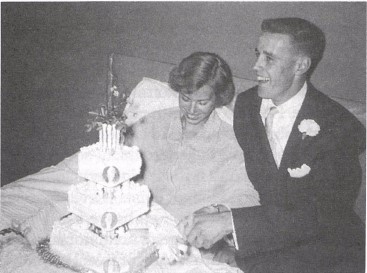
George and Marian Raham’s wedding, July 1, 1955
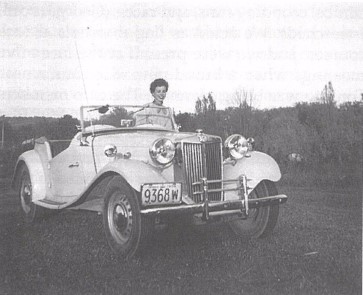
Casey with her 1952 MG TD July 1954
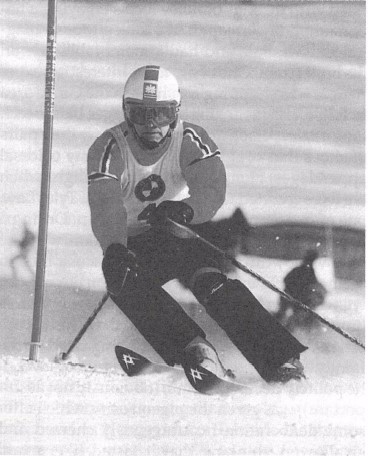
George Raham – Alberta Masters Ski Champion 1995
In Canmore Seniors at the Summit, ed. Canmore Seniors Association, 2000, p. 227-236.

